Rhododendrons for the Rock Garden
Arthur P. Dome
Seattle, Washington
Adapted from the author's seminar presented at the 1994 ARS Western Regional Conference.
The main concern really isn't what rhododendrons are suitable for the rock garden, but what rock gardens are suitable for rhododendrons. The correct environment is essential to have happy plants.
First of all, what is a rock garden? A good definition is: A rock garden should be a harmonious association of compatible plants and naturally appearing rocks that are in proper scale to the surroundings. It should also provide a suitable place to grow and display these plants without the rocks unnecessarily monopolizing the landscape.
The following conditions should be considered in planning a good rock garden environment for rhododendrons. It should have adequate light. It should be out in the open with no overhanging structures or branches. If it must be placed near large trees, make sure the lowest branches are high enough to let adequate light in. Also, consider what kind of competition the roots from these trees will be for moisture and nutrients that your rhododendrons might want. If it is too dark where they are, most will have a tendency to grow toward the light.
It should have good drainage but never be allowed to dry out. The soil must always be kept moist to the depth of the root ball. Moist is wetter than damp. When we see or read about the native habitat where most of these plants grow, it's nearly always described as moist meadows, slopes or hillsides. At the same time they won't live long in standing water. A good way to test your drainage is to prepare a planting hole and fill it full of water to see how long it will take to drain. If you're satisfied it won't be a basin of water during the rainy seasons the drainage should be satisfactory.
Allow enough space for your plants to grow. Don't stuff a plant into too small an area. Know before you plant how wide and how high it should be in five or ten years.
The soil should be a loose, friable, humus-type soil that won't pack or get hard. It should be deep enough to encourage deep root growth from your plants. If the roots can grow deep they are less apt to dry out. If the existing soil is too wet or heavy, and you still want to grow rhododendrons there, replace this soil with a more suitable soil. If this isn't practical, bring in suitable soil and raise the height of the planting area enough to accommodate the root balls of the plants. Get a soil mix that will be easy to water - one that if the surface gets a little dry the water will be more apt to soak in rather than run off.
The rock garden should be where it is protected from the hot afternoon sun. Do not allow the soil and rocks where the rhododendrons are growing to get too hot. In the wild alpine areas, they're usually growing in a cool environment and covered with fog or mist a good part of the time. In the low woodland areas the forest canopy keeps them cool. Young plants and those with shallow roots can easily get stressed and die if the soil gets too hot around their roots. Eastern or southeastern slopes are usually best. The shade can be from hills, trees, fences, buildings, rocks or anything. Sometimes a sudden surge of very hot weather in the spring after the plants have begun to grow can be devastating. Misting them with a fog nozzle can be very helpful.
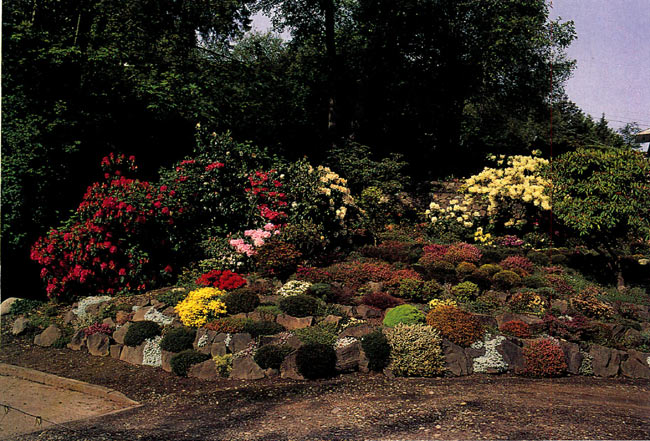
|
|
Art Dome Garden, Seattle, Wash.
Photo by Arthur P. Dome |
Even with planting rhododendrons considered suitable for your temperature zone, one should be aware of the damage that can be caused by untimely extreme cold. Also, if you are aware of areas of your rock garden that are subject to buffeting by strong winter winds it would be a good idea to plant hardier plants there and/or plan on how to protect them. A good snow cover is usually the best protection, but plans should be made to use pots, boxes, burlap, blankets or whatever it takes to protect your plants. Even some hardy plants can be damaged or killed by the sun reflecting snow in below freezing temperatures.
Sometimes there is a problem with animals wanting to dig in the soil around your small plants. One way to help protect them is to place flat rocks or shale around the plant, and as the plant grows move the rocks out and add more if needed. Also, these flat rocks help keep moisture in and weeds down.
If your rock garden has a suitable environment for growing rhododendrons, we then have to decide what plants to put in it. A lot of this depends on the size and slope of the garden: small gardens, small rocks, smaller plants and larger gardens, larger rocks, larger plants.
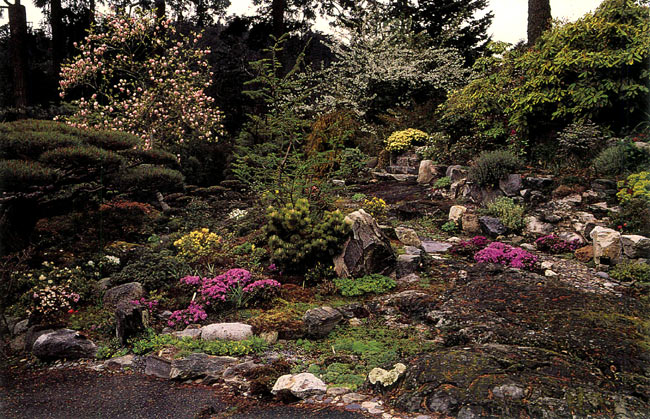
|
|
Glen Paterson Garden, West Vancouver, B.C., Canada
Photo by Arthur P. Dome |
Larger areas with steeper slopes and with larger rocks can make fine terraced-like areas for larger growing plants. Steeper, terraced planting areas are good for plants with floppy trusses and interesting indumentum, as you can look up at them from below.
Prostrate types can grow over rocks or among smaller rocks such as other low growing rhododendrons. Rock wall-type plantings can be interesting, but they are a lot harder to keep moist and some feel it isn't worth it.
In choosing your plants be sure they are cold and heat tolerant for your area. If you know what temperature zone you live in you can use that as a guide to determine this. Also it is often advisable to visit other gardens in your area, both public and private. This is also a good way to see how these plants grow and how they look in a garden setting. Specialty rhododendron nurseries, where those people know your area, can be a great help.
When you know how much space you have, how fast the plants you want will grow and how soon you want the area filled in, then you have an idea as to how many you need. Don't forget the companion plants that might be used for protection and complementing the blooming cycle for year-round color in that part of your garden. Some of the herbaceous ground cover plants are good for filling in space, and they are expendable as your woody plants grow. Discriminate pruning can help keep a plant in bounds and desirable for quite a few years. Also, use companion plants that need the same environment as your rhododendrons.
For smaller rock gardens or around smaller rocks, here are some plants you might like to consider. If you want some species in the 4 to 18 inch range in ten years, you might consider
Rhododendron camtschaticum
,
R. campylogynum
,
R. cephalanthum
,
R. forrestii
,
R. keiskei
'Yaku Fairy',
R. keleticum
(now
R. calostrotum
ssp.
keleticum
),
R. kiusianum
,
R. ludlowii
,
R. pemakoense
,
R. pumilum
,
R. prostratum
(now
R. saluenense
ssp.
chameunum
Prostratum Group) and
R. radicans
(now
R. calostrotum
ssp.
keleticum
Radicans Group).
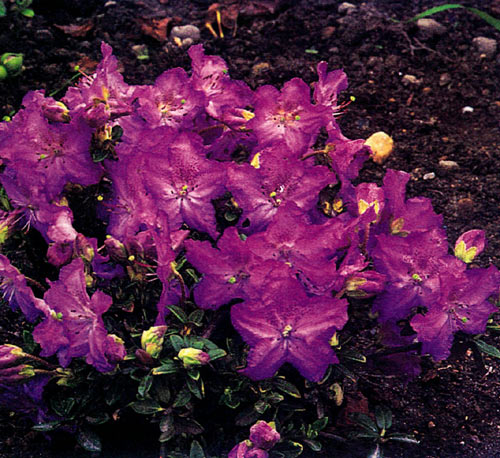
|
|
R. keleticum
Photo by Arthur P. Dome |
If you're looking for some hybrids in the 6 to 18 inch range in ten years, you might consider rhododendrons 'Carmen', 'Ernie Dee', 'Merganser', 'Patty Bee' SPA NW, 'Pipit', 'Red Red' (evergreen azalea), 'Wagtail', 'Wee Bee' and 'Wren'.
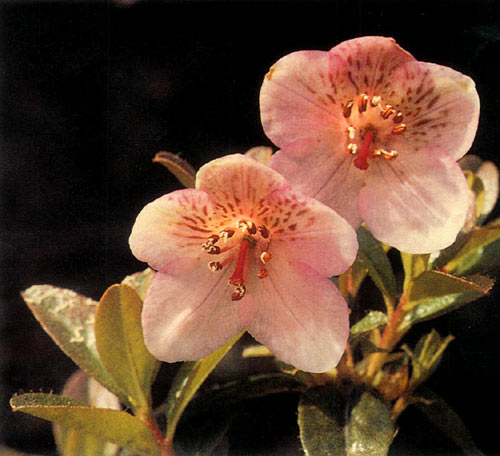
|
|
R. 'Pipit'
Photo by Arthur P. Dome |
Species to consider for larger areas in the 18 to 36 inch plus range in ten years are R. charopeum 'Patricia' (now R. campylogynum Charopaeum Group 'Patricia'), R. glaucophyllum , R hirsutum , R. intricatum , R. luteiflorum , R. megeratum , R. microleucum (now R. orthocladum var. microleucum ), R. mucronulatum 'Crater's Edge' and R. trichostomum .
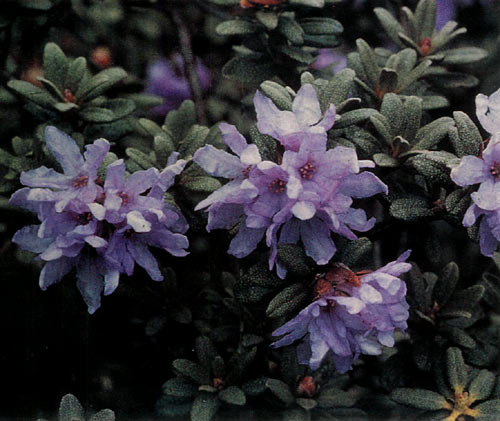
|
|
R. intricatum
Photo by Arthur P. Dome |
Some hybrids to consider in the 18 to 36 inch plus range in ten years are rhododendrons 'Bric-a-brac', 'Curlew', 'Egret', 'Ginny Gee', 'Goldilocks', 'Ptarmigan', 'Razorbill', 'Shamrock', 'Small Gem'* and 'Wigeon'.
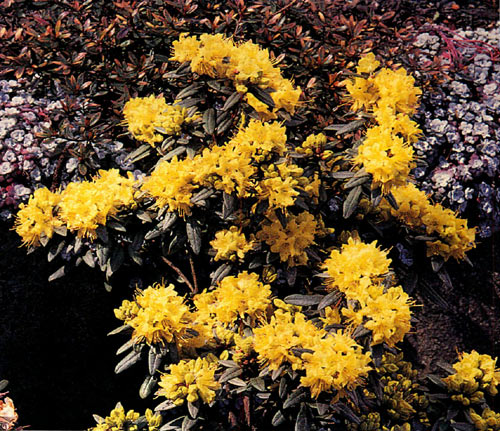
|
|
R. 'Goldilocks'
Photo by Arthur P. Dome |
There might be other rhododendrons, suitable for rock gardens that you'd like better after seeing them in your local gardens and nurseries. Again, visit the nurseries that have the selection and the people who are knowledgeable about rhododendrons.
Those nurserymen who advertise in the ARS Journal are a good reliable source for these and other plants. Send for their catalogues which are full of all kinds of expert information on the individual plants they have for sale. Most of them contain many fine color photographs to help you make your decisions. They're worth every cent that you pay for them.
* Name not registered.
Mr. Dome, a member of the Seattle Chapter, also contributed the article "Ericaceous Companion Plants which appeared in the Spring 1992 issue of the Journal.